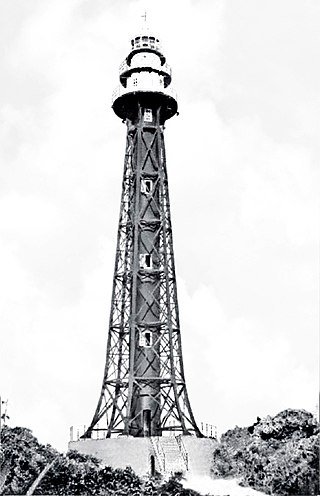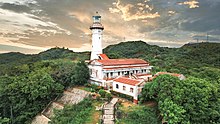
Ilocos Norte, officially the Province of Ilocos Norte, is a province of the Philippines located in the Ilocos Region. Its capital is Laoag City, located in the northwest corner of Luzon Island, bordering Cagayan and Apayao to the east, and Abra to the southeast, and Ilocos Sur to the southwest. Ilocos Norte faces the West Philippine Sea to the west and the Luzon Strait to the north.

Långe Jan is a Swedish lighthouse located at the south cape of Öland in the Baltic Sea, Sweden's second largest island. It is one of Sweden's most famous lighthouses along with Kullen, Vinga and Landsort, and also the tallest lighthouse in Sweden.

The Pointe du Grouin du Cou Lighthouse is a French lighthouse, located on the eponymous point in the southern part of the Vendée department; it guards the entrance to the Pertuis Breton on the Île de Ré, on the west side of La Tranche-sur-Mer. The lighthouse, constructed in 1953 to a design by Maurice Durand, replaces an earlier tower that was destroyed by retreating German troops during World War II.

Bagacay Point Lighthouse is an active lighthouse in Liloan, Cebu, in the Philippines.

The Pasig River Light was the first light station in the Philippines when it was established in 1642. The first lighthouse tower in the country was erected in the station and first lit in 1846. It was then located on the north jetty at the mouth of the Pasig River in San Nicolas, Manila, marking the entrance of the river for vessels cruising Manila Bay, looking to dock on the inland Port of Manila that was then located along the banks of the Pasig River in Binondo and Intramuros.
Batag Island Lighthouse is a historic lighthouse on Batag Island off the coast of the town of Laoang in the province of Northern Samar in the Philippines. The light marks the northeastern point of Samar Island and led international ships to the entrance of the San Bernardino Strait marked by the San Bernardino Light. One of the most traveled waterways in the archipelago, together with the Capul Island Light, these stations are invaluable to vessels coming from the Pacific Ocean and entering the country through the San Bernardino Strait on its way to Manila or any other ports of the Philippines.

The Cabra Island Lighthouse is a historic lighthouse built on Cabra Island, the north-westernmost of the Lubang group of islands in Occidental Mindoro, Philippines. International vessels entering the Philippines from South China Sea were welcomed by the Cabra Light and directed either towards Manila Bay or the center of the archipelago through Verde Island Passage, one of busiest sea routes of the Philippines.

The Apo Reef Light was a historic lighthouse built on Bajo Apo Island in Apo Reef Natural Park. The park is located in the middle of Mindoro Strait, west of the province of Occidental Mindoro, in the Philippines. The station was established to warn ships of the dangerous shallow reefs in that part of the strait.

Cape Engaño Lighthouse, also known as Faro de Cabo Engaño, is a historic lighthouse located at Cape Engaño on Palaui Island in the town of Santa Ana, the province of Cagayan, Philippines. Located at the northernmost part of Luzon Island and situated atop the summit of a hill, 92 meters above sea level, the lighthouse provides a 360-degree view of Babuyan Island and the Dos Hermanas Island on the North, Pacific Ocean on the West and Engaño cove on the East.

Capones Island Lighthouse is a historic lighthouse located in Capones Island off the coast of Barangay Pundaquit, San Antonio, in the province of Zambales, in the Philippines. The light guides international vessels coming from the north to northwest towards Subic Bay or to Corregidor Island Lighthouse at the entrance of Manila Bay. It had first-order lenses when it was first lit on August 1, 1890.

The first Corregidor Island Lighthouse was a historic lighthouse located on the island of Corregidor, in the province of Cavite, Philippines. The light station was one of the most important lights in the archipelago. It was established in 1853 to guide ships to the entrance of Manila Bay on their way to the port of Manila, the most important trading center in the country. This light occupies the converging point of two lines of approach for vessels from the China Sea which steer for the entrance of Manila Bay. Vessels from Hong Kong and the ports of China to the northwest first sight the Capones Island light off the southwest coast of Zambales. Vessels from ports of Indo-China first sight the Corregidor lights in the center. Vessels from Singapore, Indonesia, India, and all the ports of the Philippine Islands, to the south, first sight the Cabra Island light. All lines converge on Corregidor light at the bay entrance.

Grönskär is a Swedish island and lighthouse station located in the south Stockholm archipelago, east of Sandhamn. The island is rocky and the nature sparse. The herb cloudberry has been found on the island. The whole island is owned by the Swedish foundation "Skärgårdsstiftelsen". since 1964. The foundation also owns the lighthouse since 1984.

The Cape Finisterre Lighthouse is an active lighthouse on Cape Finisterre, in the Province of A Coruña, on the northwestern coast of Galicia in Spain.

Islas de Gigantes is an island chain within the larger Western Visayas archipelago in the Visayan Sea. It is part of the municipality of Carles, Iloilo, Philippines, and the northernmost part of Iloilo province. The Gigantes islands consist of about ten islands; the two largest are Gigantes Norte and Gigantes Sur. According to the 2010 census, it has a population of 12,224. There is also a lighthouse on Gigantes Norte.
Manigonigo Island is an island in northeastern Iloilo, Philippines. It is one of fourteen islands politically administered by the municipality of Carles. The island's lighthouse was built by the Spanish during Spanish rule.

Capitancillo is a small coral island near Bogo, Cebu, Philippines. The island is a protected marine sanctuary, featuring three dive sites and a lighthouse.

Cape Bojeador is the northwestern tip of the island of Luzon in the Philippines. It is a headland on the South China Sea coast of the municipality of Burgos, Ilocos Norte, some 40 kilometres (25 mi) north of Laoag. The cape is best known for its Spanish lighthouse, the most visited lighthouse in the country and a favorite shooting venue for local movies and television series.

Cape Santiago Lighthouse, also known as Faro de Cabo Santiago, is a historic lighthouse located about 130 kilometres (81 mi) southwest of Manila in Barangay Bagong Silang, Calatagan, Batangas, Philippines. It is the oldest working lighthouse in Batangas and one of the oldest working lighthouses in the Philippines. It serves as a guide for ships passing through the Verde Island Passage and entering Manila Bay.

Malabrigo Point Lighthouse, also known as Faro de Punta Malabrigo, is a historic lighthouse located about 115 kilometres (71 mi) southeast of Manila in Barangay Malabrigo, Lobo, Batangas, Philippines. Completed and lit in 1896, it is one of the oldest working lighthouses in the Philippines as well as the best preserved lighthouse in the country. It serves as a guide for ships passing through the Verde Island Passage going to either Batangas Bay or Sibuyan Sea.



























